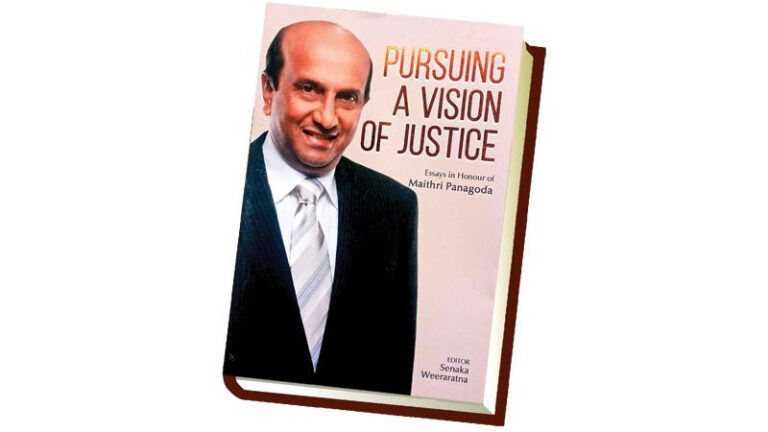
Publication – Pursing a vision of Justice, Essays in Honour of Maithri Panagoda – a Biography
Editor – Senaka Weerarathna
Publisher – Vijitha Yapa Publications
Reviewed by – Advocate, Dr. Namel Weeramuni
“Let no young man choosing the law for a calling for a moment yield to the popular belief – resolve to be honest at all events; and if in your own judgement you cannot be an honest lawyer, resolve to be honest without being a lawyer” – Abraham Lincoln – Notes for lecture, circa July 1, 1850
Inherently Maithri Panagoda fits to this characteristic without any reservation. His behaviour and actions are beyond doubt. Everything about him is evident in this book titled “Pursuing a Vision of Justice.”
The book, edited by Senaka Weerarathna, is composed in 15 Parts and 30 Chapters which are written as Essays in Honour of Maithri Panagoda. Its Forward has been written by Dr. Palitha Kohona titling ‘Maithri, a friend, a colleague and outstanding patriot’. Essays have been penned by a few Australian Supreme Court Judges, legal luminaries such as Queens Counsels, and a few other reputed Australian Lawyers, and in particular, Prof. Laskhman Marasinghe writing about World Court Justice late C. G. Weeramanthry referring to the camaraderie he had with Maithri and indeed Prof. Dayantha Laksiri Mendis, now a world figure in law being at the very outset an Assistant Legal Draftsman in the Legal Draftsmen Department of then Ceylon.
Wealth of information supplied by Barbara Flick, Eric Wilson, Brian Hancock, Erick Wilson, of the Western Aboriginal Legal Services (WALS) relating to Maithri’s contribution to the Aboriginal Community in Dubbo was overwhelming to say the least. Equally valuable were the insights provided by Hannan Indari and Rafqa Touma of the law firm of Carrol and O’Dea, which is one of the oldest (140 years) and prestigious law firms in Sydney. Maithri is a senior partner of this firm.
Recognition in Australia
An important thing to note is that Australia acknowledged Maithri’s service to his adopted country by awarding him “Member of the Order of Australia” in 1916” which becomes very significant for him to live in the country as a respected and valued personage, VIP or public figure.
